The Prediction of Tea Production Using Dynamic Rolling Update Grey Model: A Case Study of China
Abstract
1. Introduction
2. Materials and Methods
2.1. Data
2.2. GM (1,1) Model
2.3. Markov-GM (1,1) Model
2.4. PSO-Markov-GM (1,1) Model
2.5. Dynamic Rolling Update GM (1,1) (DRUGM) Model
2.6. Model Performance Evaluation Index
3. Results
3.1. Case 1: Tea Production from 2004 to 2023
3.2. Case 2: Tea Production from 2004 to 2013
3.3. Case 3: Tea Production from 2014 to 2023
3.4. Provincial-Level Tea Production from 2004 to 2023
4. Discussion
5. Conclusions
Author Contributions
Funding
Data Availability Statement
Acknowledgments
Conflicts of Interest
Abbreviations
| ANN | Artificial neural network |
| APE | Absolute percentage error |
| ARIMA | Auto regressive integrated moving average |
| BGM | Box plot grey model |
| CNN | Convolutional neural networks |
| ConvLSTM | Convolutional long short-term memory |
| DCNN | Dimensional convolutional neural network |
| DGM | Discrete grey model |
| DNGM | Discrete nonlinear grey model |
| DRS-RF | Dragonfly optimization algorithm and support vector regression-random forest |
| DRUGM | Dynamic rolling update grey model |
| DT | Decision tree |
| ELNET | Elastic net |
| FANGBM | Fractional accumulating nonlinear grey Bernoulli model |
| FOANGBMKM | Fractional opposite-direction accumulating nonlinear grey Bernoulli Markov model |
| GA | Genetic algorithm |
| GBDT | Gradient-boosted decision tree |
| GM | Grey model |
| GP | Gaussian processor |
| GRPM | Grey rolling prediction model |
| GTWNN | Geographically and temporally weighted neural network |
| GTWR | Geographically and temporally weighted regression |
| GVM | General vector machine |
| GWO | Grey wolf optimizer |
| KGM | Kernel-based multivariate nonlinear grey model |
| LASSO | Least absolute shrinkage and selection operator |
| LR | Linear regression |
| LSTM | Long short-term memory |
| MAE | Mean absolute error |
| MAPE | Mean absolute percentage error |
| Markov-GM | Markov chain grey model |
| NGBM | Nonlinear grey Bernoulli model |
| PR | Polynomial regression |
| PSO | Particle swarm optimization |
| PSO-Markov-GM | Particle swarm optimization Markov chain grey model |
| RF | Random forest |
| RGVM | Rolling grey Verhulst model |
| RLR | Robust linear regression |
| RMSE | Root mean squared error |
| SARIMA | Seasonal ARIMA |
| SMLR | Stepwise multiple linear regression |
| SVM | Support vector machine |
| SVR | Support vector regression |
| UAVs | Unmanned aerial vehicles |
| XGBoost | Extreme gradient boosting |
References
- Chen, C.; Lu, J.; Zhou, M.; Yi, J.; Liao, M.; Gao, Z. A YOLOv3-Based Computer Vision System for Identification of Tea Buds and the Picking Point. Comput. Electron. Agric. 2022, 198, 107116. [Google Scholar] [CrossRef]
- Qu, Z.; Liu, A.; Li, P.; Liu, C.; Xiao, W.; Huang, J.; Liu, Z.; Zhang, S. Advances in Physiological Functions and Mechanisms of (−)-Epicatechin. Crit. Rev. Food Sci. Nutr. 2021, 61, 211–233. [Google Scholar] [CrossRef]
- Zhou, J.; Ho, C.; Long, P.; Meng, Q.; Zhang, L.; Wan, X. Preventive Efficiency of Green Tea and Its Components on Nonalcoholic Fatty Liver Disease. J. Agric. Food Chem. 2019, 67, 5306–5317. [Google Scholar] [CrossRef]
- Jayasinghe, S.L.; Kumar, L. Climate Change May Imperil Tea Production in the Four Major Tea Producers According to Climate Prediction Models. Agronomy 2020, 10, 1536. [Google Scholar] [CrossRef]
- Nurman, S.; Nusrang, M.; Sudarmin. Analysis of Rice Production Forecast in Maros District Using the Box-Jenkins Method with the ARIMA Model. ARRUS J. Math. Appl. Sci. 2022, 2, 36–48. [Google Scholar] [CrossRef]
- Noorunnahar, M.; Chowdhury, A.H.; Mila, F.A. A Tree Based EXtreme Gradient Boosting (XGBoost) Machine Learning Model to Forecast the Annual Rice Production in Bangladesh. PLoS ONE 2023, 18, 0283452. [Google Scholar] [CrossRef]
- Devi, M.; Kumar, J.; Malik, D.P.; Mishra, P. Forecasting of Wheat Production in Haryana Using Hybrid Time Series Model. J. Agric. Food Res. 2021, 5, 100175. [Google Scholar] [CrossRef]
- Chergui, N. Durum Wheat Yield Forecasting Using Machine Learning. Artif. Intell. Agric. 2022, 6, 156–166. [Google Scholar] [CrossRef]
- Zhang, X.; Bao, J.; Xu, S.; Wang, Y.; Wang, S. Prediction of China’s Grain Consumption from the Perspective of Sustainable Development—Based on GM (1,1) Model. Sustainability 2022, 14, 10792. [Google Scholar] [CrossRef]
- Wu, Y.; Zhou, R.; Yu, B.; Huang, X.; Li, B. Grain Yield Prediction Based on the Improved Unbiased Grey Markov Model. Discret. Dyn. Nat. Soc. 2025, 2025, 8282138. [Google Scholar] [CrossRef]
- Saha, J.K.; Adnan, K.M.M.; Sarker, S.A.; Bunerjee, S. Analysis of Growth Trends in Area, Production and Yield of Tea in Bangladesh. J. Agric. Food Res. 2021, 4, 100136. [Google Scholar] [CrossRef]
- Mila, F.A.; Noorunnahar, M.; Nahar, A.; Acharjee, D.C.; Parvin, M.T.; Culas, R.J. Modelling and Forecasting of Tea Production, Consumption and Export in Bangladesh. Curr. Appl. Sci. Technol. 2022, 22. [Google Scholar] [CrossRef]
- Jui, S.J.J.; Ahmed, A.A.M.; Bose, A.; Raj, N.; Sharma, E.; Soar, J.; Chowdhury, M.W.I. Spatiotemporal Hybrid Random Forest Model for Tea Yield Prediction Using Satellite-Derived Variables. Remote Sens. 2022, 14, 805. [Google Scholar] [CrossRef]
- Ryan, A.A.; Kh Shuvessa, S.; Mamun, S.; Arpita, H.D.; Ahamed, M.S. Forecasting Tea Production in the Context of Bangladesh Utilizing Machine Learning. In Proceedings of the 2023 14th International Conference on Computing Communication and Networking Technologies, ICCCNT 2023, Delhi, India, 6–8 July 2023; Institute of Electrical and Electronics Engineers Inc.: New York, NY, USA, 2023. [Google Scholar]
- Satpathi, A.; Setiya, P.; Das, B.; Nain, A.S.; Jha, P.K.; Singh, S.; Singh, S. Comparative Analysis of Statistical and Machine Learning Techniques for Rice Yield Forecasting for Chhattisgarh, India. Sustainability 2023, 15, 2786. [Google Scholar] [CrossRef]
- Feng, L.; Wang, Y.; Zhang, Z.; Du, Q. Geographically and Temporally Weighted Neural Network for Winter Wheat Yield Prediction. Remote Sens. Environ. 2021, 262, 112514. [Google Scholar] [CrossRef]
- Gavahi, K.; Abbaszadeh, P.; Moradkhani, H. DeepYield: A Combined Convolutional Neural Network with Long Short-Term Memory for Crop Yield Forecasting. Expert. Syst. Appl. 2021, 184, 15511. [Google Scholar] [CrossRef]
- Batool, D.; Shahbaz, M.; Shahzad Asif, H.; Shaukat, K.; Alam, T.M.; Hameed, I.A.; Ramzan, Z.; Waheed, A.; Aljuaid, H.; Luo, S. A Hybrid Approach to Tea Crop Yield Prediction Using Simulation Models and Machine Learning. Plants 2022, 11, 1925. [Google Scholar] [CrossRef]
- Islam, M.A.; Sumy, M.S.A.; Uddin, M.A.; Hossain, M.S. Fitting ARIMA Model and Forecasting for the Tea Production, and Internal Consumption of Tea (per Year) and Export of Tea. Int. J. Mater. Math. Sci. 2020, 2, 8–15. [Google Scholar] [CrossRef]
- Arigela, S.; Naidu, M.B.; Reddy, M.P.R.; Murali, K.; Rayalu, G.M. Tea Crop Yield Prediction Using Time Series Models in Kerala. Int. J. Food Nutr. Sci. 2022, 11, 761–773. [Google Scholar]
- Phan, P.; Chen, N.; Xu, L.; Chen, Z. Using Multi-Temporal MODIS NDVI Data to Monitor Tea Status and Forecast Yield: A Case Study at Tanuyen, Laichau, Vietnam. Remote Sens. 2020, 12, 1814. [Google Scholar] [CrossRef]
- Deng, J. Control Problems of Grey Systems. Syst. Control Lett. 1982, 1, 288–294. [Google Scholar] [CrossRef]
- Chang, C.J.; Li, D.C.; Huang, Y.H.; Chen, C.C. A Novel Gray Forecasting Model Based on the Box Plot for Small Manufacturing Data Sets. Appl. Math. Comput. 2015, 265, 400–408. [Google Scholar] [CrossRef]
- Xie, M.; Wu, L.; Li, B.; Li, Z. A Novel Hybrid Multivariate Nonlinear Grey Model for Forecasting the Traffic-Related Emissions. Appl. Math. Model. 2020, 77, 1242–1254. [Google Scholar] [CrossRef]
- Gao, J.; Li, J.; Wang, M. Time Series Analysis of Cumulative Incidences of Typhoid and Paratyphoid Fevers in China Using Both Grey and SARIMA Models. PLoS ONE 2020, 15, e0241217. [Google Scholar] [CrossRef]
- Yuan, C.; Liu, S.; Fang, Z. Comparison of China’s Primary Energy Consumption Forecasting by Using ARIMA (the Autoregressive Integrated Moving Average) Model and GM (1,1) Model. Energy 2016, 100, 384–390. [Google Scholar] [CrossRef]
- Liu, L.; Xie, A.; Ping, H. Research on Freight Development of Guangdong Province Based on Grey Theory Model. Math. Probl. Eng. 2021, 2021, 5401499. [Google Scholar] [CrossRef]
- Jia, Z.Q.; Zhou, Z.F.; Zhang, H.J.; Li, B.; Zhang, Y.X. Forecast of Coal Consumption in Gansu Province Based on Grey-Markov Chain Model. Energy 2020, 199, 117444. [Google Scholar] [CrossRef]
- Elgharbi, S.; Esghir, M.; Ibrihich, O.; Abarda, A.; El Hajji, S.; Elbernoussi, S. Grey-Markov Model for the Prediction of the Electricity Production and Consumption. In Big Data and Networks Technologies. BDNT 2019. Lecture Notes in Networks and Systems; Farhaoui, Y., Ed.; Springer: Berlin/Heidelberg, Germany, 2020; Volume 81, pp. 206–219. [Google Scholar]
- Yuan, D.; Geng, C.; Zhang, L.; Zhang, Z. Application of Gray-Markov Model to Land Subsidence Monitoring of a Mining Area. IEEE Access 2021, 9, 118716–118725. [Google Scholar] [CrossRef]
- Jin, X.; Zheng, J.; Geng, X. Prediction of Road Traffic Accidents Based on Grey System Theory and Grey Markov Model. Int. J. Saf. Secur. Eng. 2020, 10, 263–268. [Google Scholar] [CrossRef]
- Qiu, M.; Li, D.; Luo, Z.; Yu, X. Huizhou GDP Forecast Based on Fractional Opposite-Direction Accumulating Nonlinear Grey Bernoulli Markov Model. Electron. Res. Arch. 2023, 31, 947–960. [Google Scholar] [CrossRef]
- Xu, Y.; Lin, T.; Du, P. A Hybrid Coal Prediction Model Based on Grey Markov Optimized by GWO—A Case Study of Hebei Province in China. Expert Syst. Appl. 2024, 235, 121194. [Google Scholar] [CrossRef]
- Zheng, C.; Wu, W.; Xie, W.; Li, Q.; Zhang, T. Forecasting the Hydroelectricity Consumption of China by Using a Novel Unbiased Nonlinear Grey Bernoulli Model. J. Clean. Prod. 2021, 278, 123903. [Google Scholar] [CrossRef]
- Zhou, W.; Zeng, B.; Wang, J.; Luo, X.; Liu, X. Forecasting Chinese Carbon Emissions Using a Novel Grey Rolling Prediction Model. Chaos Solitons Fractals 2021, 147, 110968. [Google Scholar] [CrossRef]
- Zhao, Y.; Shou, M.; Wang, Z. Prediction of the Number of Patients Infected with COVID-19 Based on Rolling Grey Verhulst Models. Int. J. Environ. Res. Public Health 2020, 17, 4582. [Google Scholar] [CrossRef]
- Zhang, H.; Chen, Y. Analysis and Application of Grey-Markov Chain Model in Tax Forecasting. J. Math. 2021, 2021, 9918411. [Google Scholar] [CrossRef]
- Gonçalves, J.P.S.; Fruett, F.; Dalfré Filho, J.G.; Giesbrecht, M. Faults Detection and Classification in a Centrifugal Pump from Vibration Data Using Markov Parameters. Mech. Syst. Signal Process 2021, 158, 107694. [Google Scholar] [CrossRef]
- Yin, G.G.; Zhang, Q. Discrete-Time Markov Chainstwo-Time-Scale Methods and Applications; Springer: New York, NY, USA, 2005. [Google Scholar]
- Shi, Y.; Eberhart, R. A Modified Particle Swarm Optimizer. In Proceedings of the 1998 IEEE International Conference on Evolutionary Computation Proceedings, IEEE World Congress on Computational Intelligence (Cat. No.98TH8360), Anchorage, AK, USA, 4–9 May 1998. [Google Scholar]
- Twumasi, E.; Frimpong, E.A.; Kwegyir, D.; Folitse, D. Improvement of Grey System Model Using Particle Swarm Optimization. J. Electr. Syst. Inf. Technol. 2021, 8, 12. [Google Scholar] [CrossRef]
- Castillo, M.; Soto, R.; Crawford, B.; Castro, C.; Olivares, R. A Knowledge-Based Hybrid Approach on Particle Swarm Optimization Using Hidden Markov Models. Mathematics 2021, 9, 1417. [Google Scholar] [CrossRef]
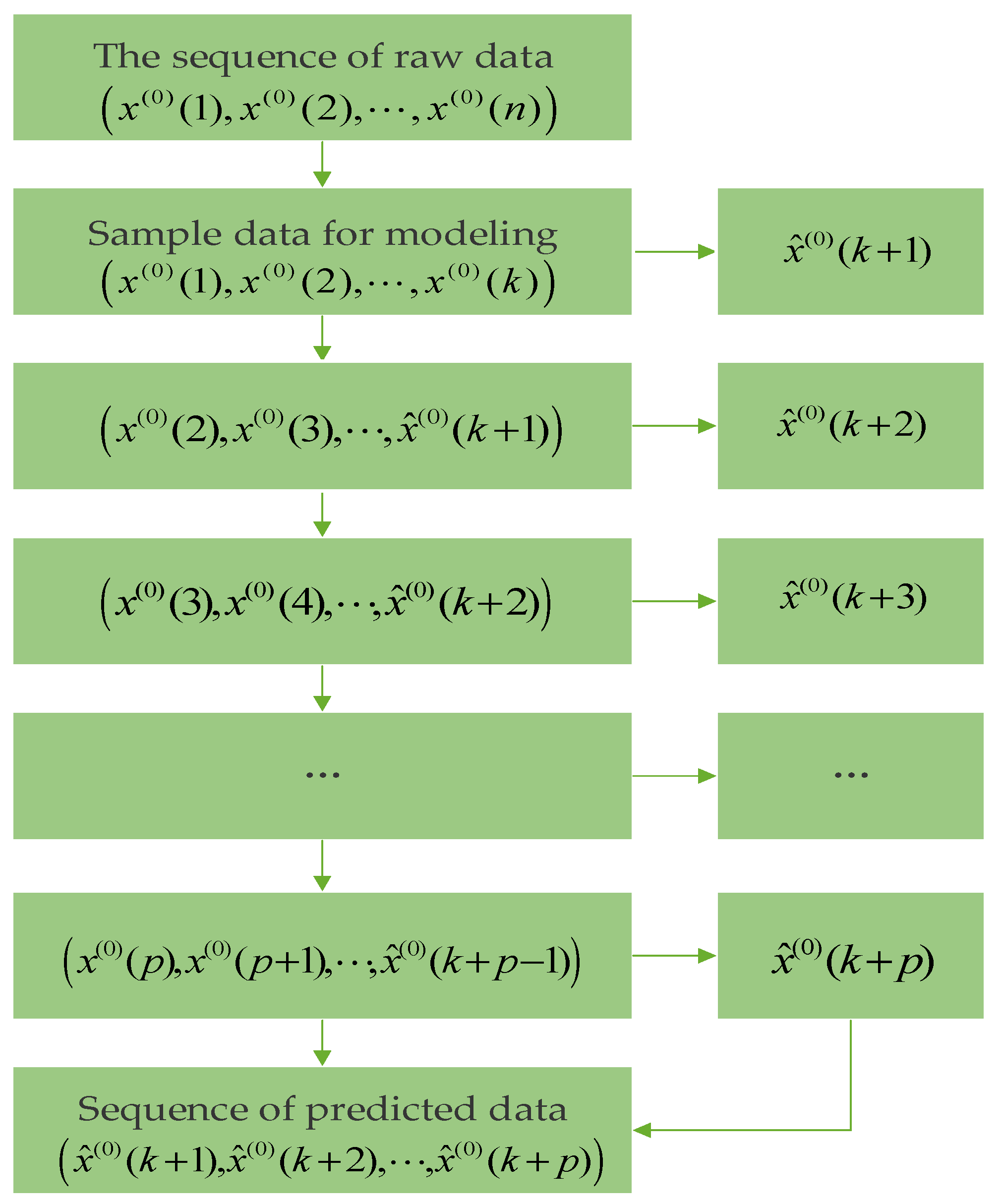
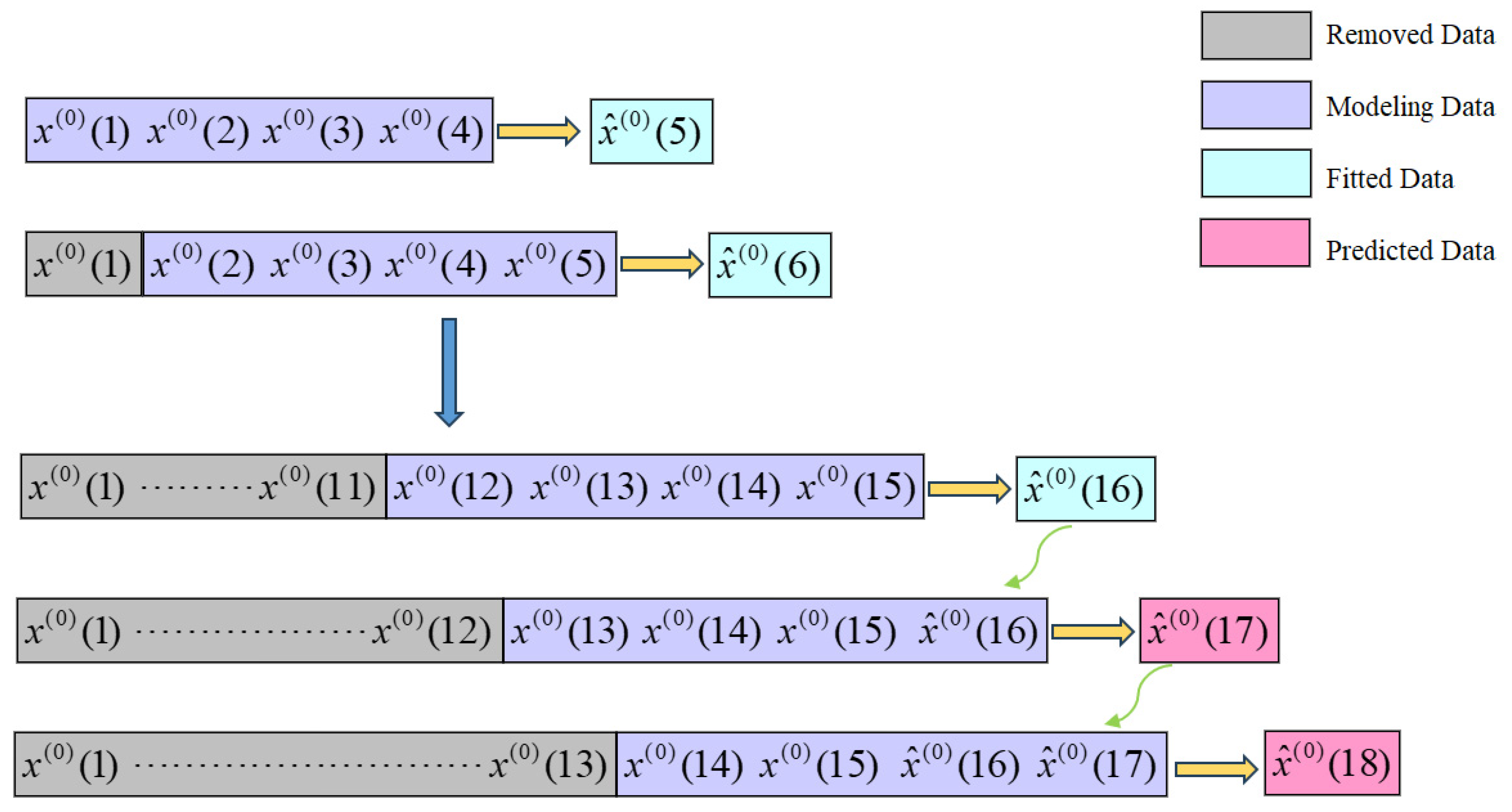
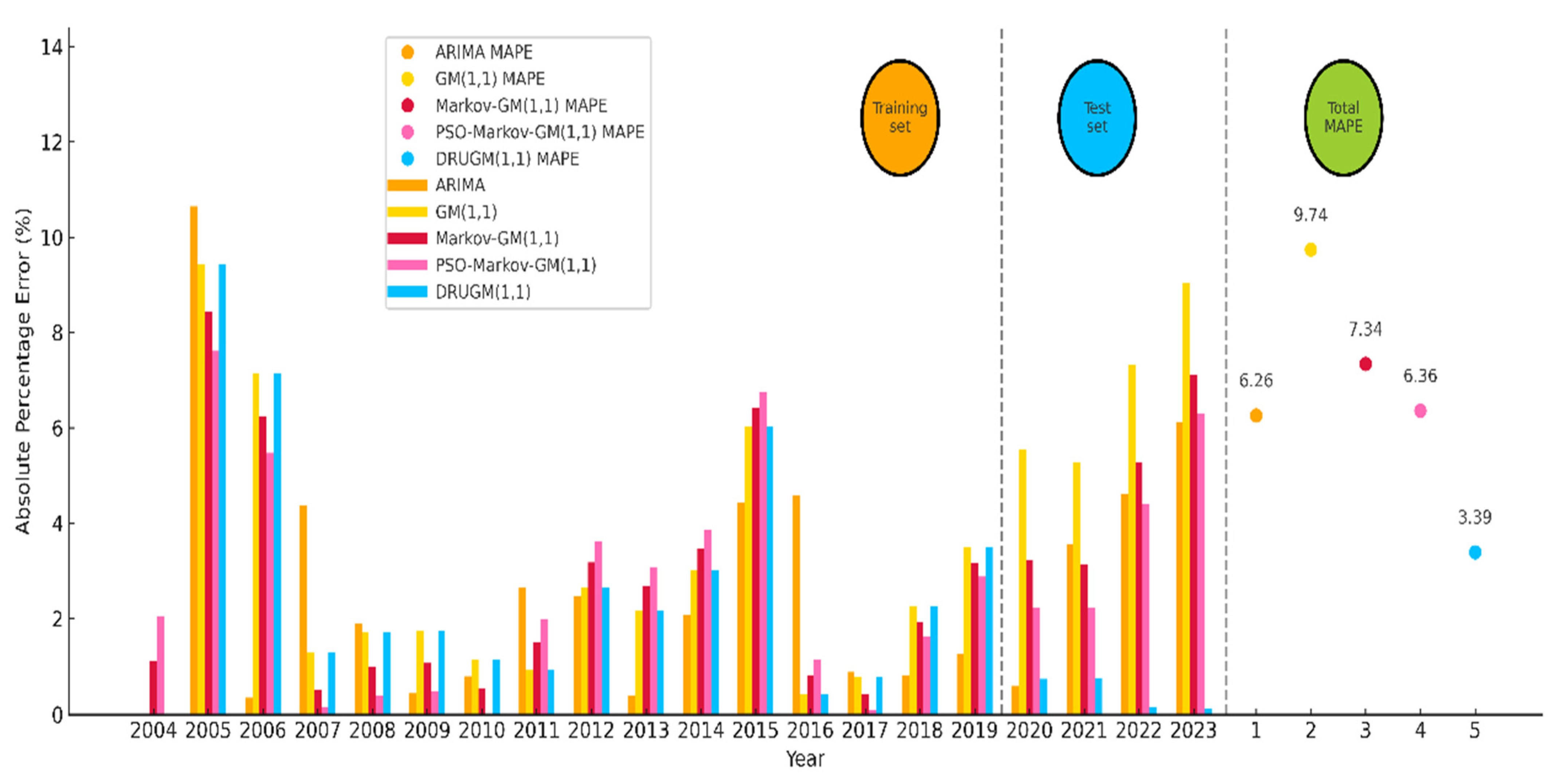
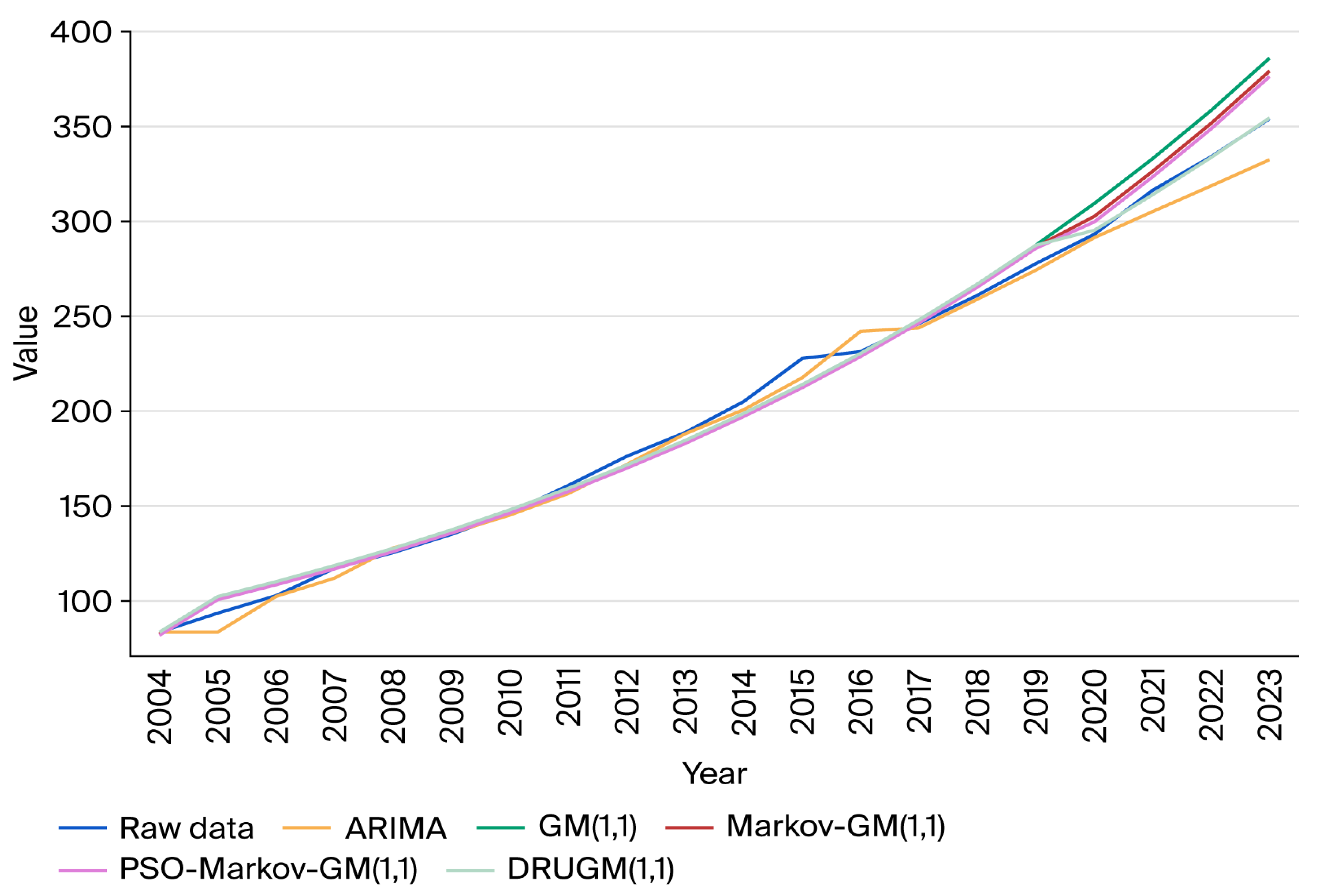
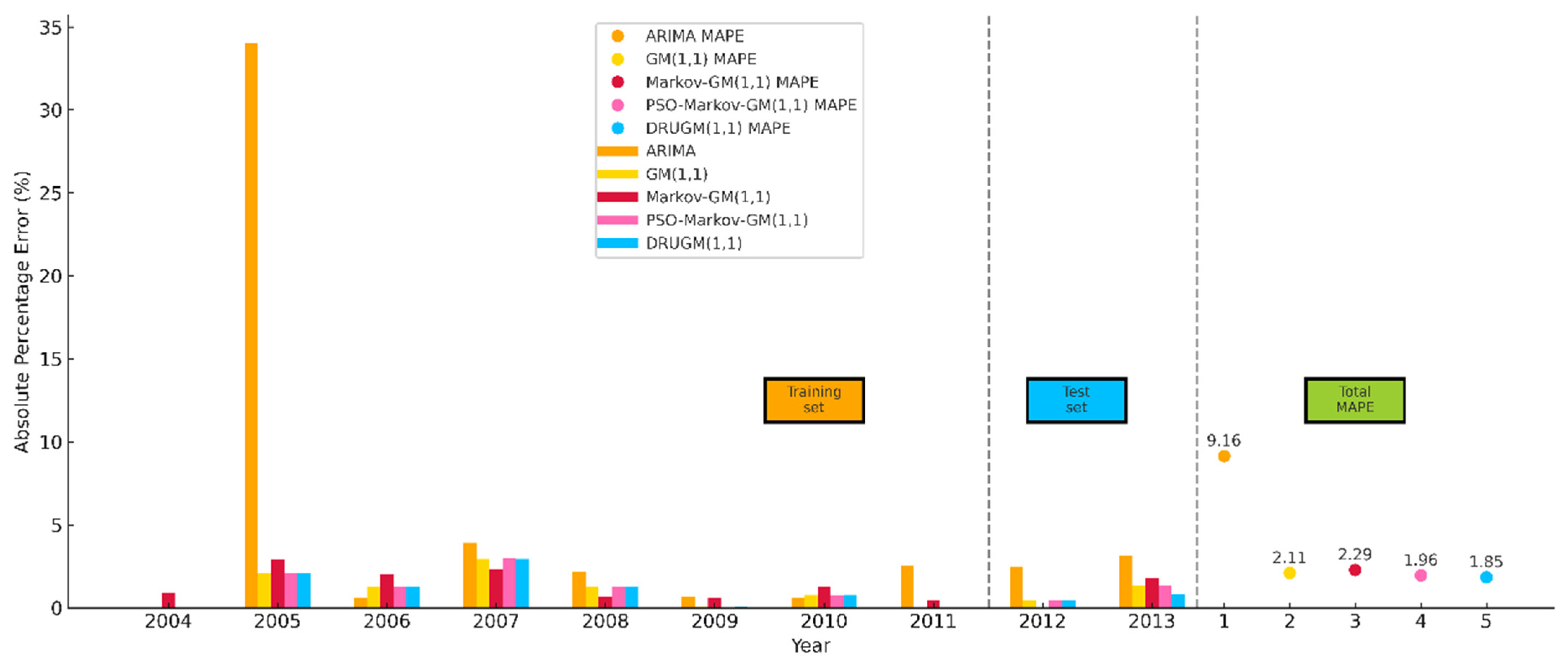
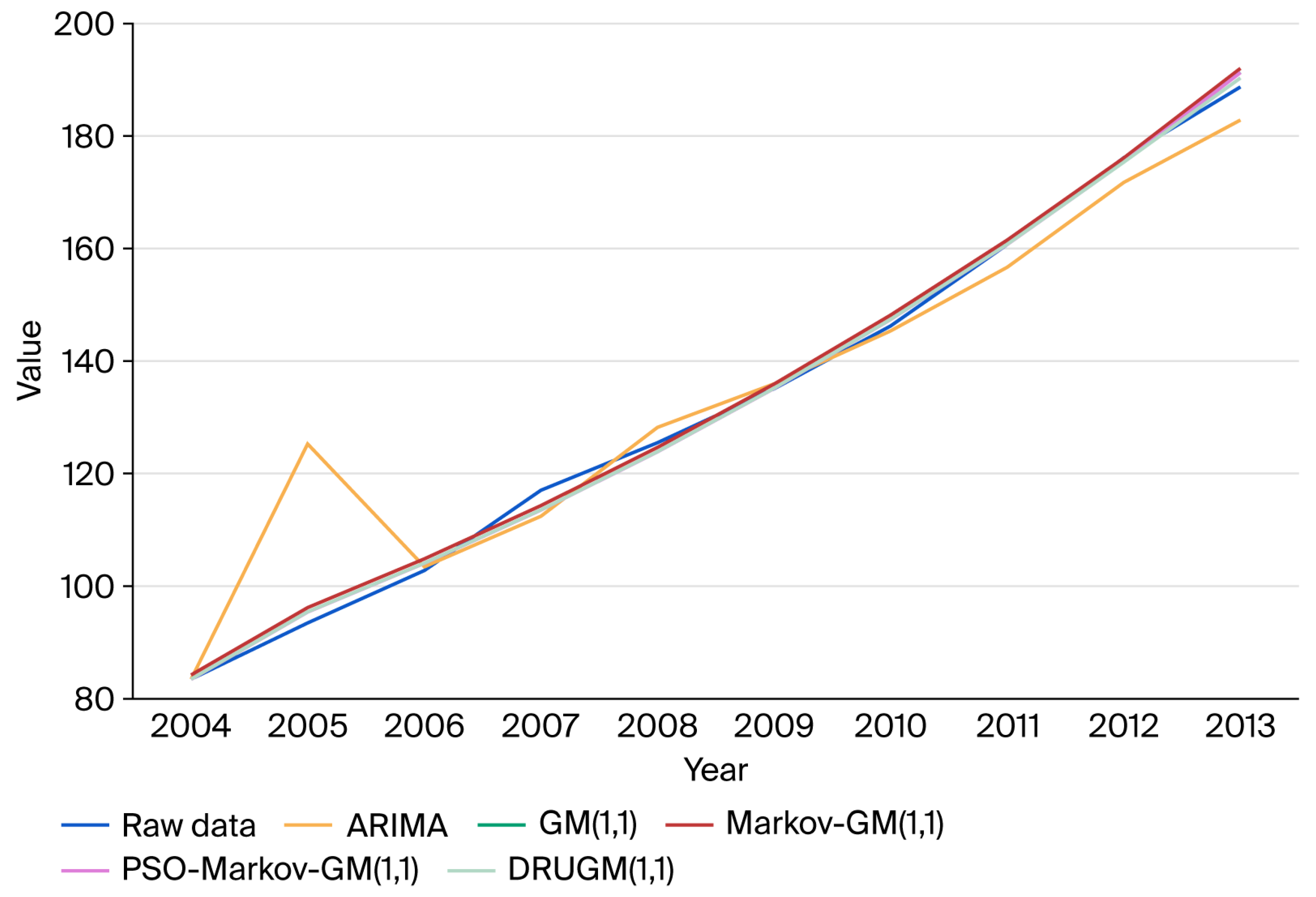

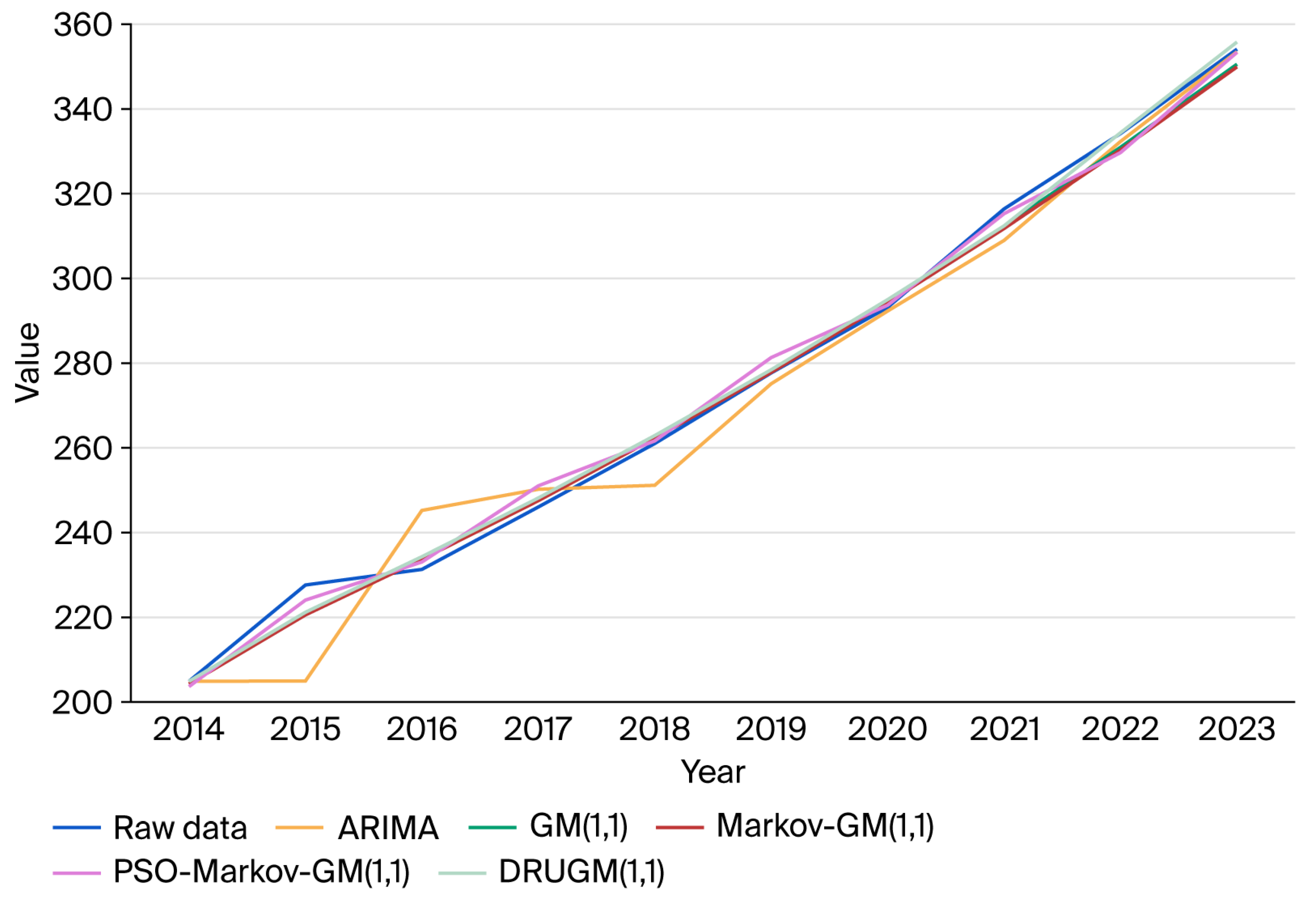
| References | Models | Findings |
|---|---|---|
| Satpathi et al. [15] | SMLR, ANN, LASSO, ELNET, Ridge regression | Ensemble models achieved better results than single models. |
| Feng et al. [16] | GTWNN, ANN, GTWR, SVR | GTWNN has lower errors and can effectively solve spatial non stationarity in the prediction modeling process. |
| Gavahi et al. [17] | 3DCNN, ConvLSTM, DeepYield | DeepYield’s performance is significantly better than all modeling techniques, including ConvLSTM and 3DCNN. |
| Batool et al. [18] | AquaCrop, Machine learning | The machine learning regression algorithm outperformed the simulation model with less data. |
| Islam et al. [19] | ARIMA | ARIMA (0,1,1) can predict the tea production in Bangladesh very well |
| Arigela et al. [20] | ARIMA, SARIMA | The SARIMA model provides a deeper understanding of seasonal factors that affect yield. |
| Phan et al. [21] | SVM, RF, LR | The predictive performance of different models varies in different periods. |
| References | Models | Findings |
|---|---|---|
| Chang et al. [23] | BGM (1,1), GM (1,1) | The BGM (1,1) model has better prediction performance and is a useful tool for manufacturing enterprises, which can be applied to other practical industrial cases in the future. |
| Xie et al. [24] | KGM (1, N), SVR, RLR | The results of KGM (1, N) are significantly better than those of RLR and SVR prediction models. |
| Gao et al. [25] | SARIMA, GM (1,1) | SARIMA (0,1,7) × (1,0,1)12 performed better than GM (1,1), and Children aged 0–4 have been a high-risk group in recent years. The three provinces in southwest China (Yunnan, Guizhou and Guangxi) have the highest incidence rate. |
| Yuan et al. [26] | ARIMA, GM (1,1), GM-ARIMA | The GM-ARIMA performed the best. |
| Liu et al. [27] | GM (1,1) | Analyze the impact of COVID-19 on Guangdong’s transportation and find out the related factors of Guangdong’s freight growth. |
| Jia et al. [28] | Markov-GM | The average relative error predicted by Markov-GM (1,1) is much lower than before correction |
| Elgharbi et al. [29] | Markov-GM, GM (1,1) | Markov-GM has higher prediction accuracy and better prediction results. Electricity production and consumption will show significant growth in the future. |
| Yuan et al. [30] | Markov-GM, GM (1,1) | Compared with traditional grey models, grey Markov models can better reflect the volatility and practicality of subsidence data in mining areas. |
| Jin et al. [31] | Markov-GM, GM (1,1) | In terms of predicting road traffic accidents, the accuracy of Markov-GM is significantly higher than others. |
| Qiu et al. [32] | FOANGBMKM, FANGBM | The predictive performance of FOANGBMKM (1,1) is superior to the other four competing models, proving that this model has higher accuracy and efficiency. |
| Xu et al. [33] | Markov-DNGM, GWO-Markov-DNGM | The Markov chain state interval partitioning hybrid model optimized by GWO algorithm has higher reliability in predicting coal consumption compared to models that partition state intervals based on experience. |
| Zheng et al. [34] | PR(n), ARIMA, ANN, GVM (1,1), NGBM, PSO-Unbiased NGBM | Using PSO algorithm to optimize model parameters improves prediction accuracy and outperforms other algorithms. |
| Zhou et al. [35] | GM (1,1), DGM (1,1), GRPM (1,1), LR model | Compared with the other two classic prediction models that did not consider the priority of new information, GRPM (1,1) has higher stability. |
| Zhao et al. [36] | RGVM | RGVM and its derivative forms can effectively predict changes in patient populations. |
| Zhang and Chen [37] | GM (1,1), Markov chain, Markov-GM | Markov-GM can better perform tax analysis and prediction. |
| Sample | Minimum (10,000 Tons) | Maximum (10,000 Tons) | Average (10,000 Tons) | Standard Deviation (10,000 Tons) |
|---|---|---|---|---|
| 2004–2023 | 83.52 | 354.11 | 203.80 | 81.70 |
| 2004–2013 | 83.52 | 188.72 | 132.93 | 33.39 |
| 2014–2023 | 204.93 | 354.11 | 274.66 | 46.80 |
| Year | Raw Data | ARIMA | GM (1,1) | Markov-GM (1,1) | PSO-Markov-GM (1,1) | DRUGM (1,1) |
|---|---|---|---|---|---|---|
| APE (%) | APE (%) | APE (%) | APE (%) | APE (%) | ||
| 2004 | 83.52 | 0.00 | 0.00 | 1.11 | 2.04 | 0.00 |
| 2005 | 93.49 | 10.65 | 9.43 | 8.44 | 7.61 | 9.43 |
| 2006 | 102.81 | 0.35 | 7.13 | 6.23 | 5.47 | 7.13 |
| 2007 | 117.05 | 4.38 | 1.30 | 0.51 | 0.15 | 1.30 |
| 2008 | 125.48 | 1.91 | 1.73 | 0.99 | 0.38 | 1.73 |
| 2009 | 135.06 | 0.44 | 1.75 | 1.07 | 0.49 | 1.75 |
| 2010 | 146.25 | 0.80 | 1.16 | 0.53 | 0.00 | 1.16 |
| 2011 | 160.76 | 2.66 | 0.92 | 1.50 | 1.98 | 0.92 |
| 2012 | 176.15 | 2.47 | 2.65 | 3.18 | 3.62 | 2.65 |
| 2013 | 188.72 | 0.40 | 2.18 | 2.67 | 3.08 | 2.18 |
| 2014 | 204.93 | 2.09 | 3.02 | 3.47 | 3.85 | 3.02 |
| 2015 | 227.66 | 4.44 | 6.02 | 6.42 | 6.76 | 6.02 |
| 2016 | 231.33 | 4.59 | 0.43 | 0.82 | 1.16 | 0.43 |
| 2017 | 246.04 | 0.89 | 0.79 | 0.41 | 0.10 | 0.79 |
| 2018 | 261.04 | 0.82 | 2.27 | 1.92 | 1.62 | 2.27 |
| 2019 | 277.72 | 1.26 | 3.49 | 3.16 | 2.88 | 3.49 |
| MAPE | 2.54 | 2.95 | 2.65 | 2.57 | 2.95 | |
| 2020 | 293.18 | 0.59 | 5.54 | 3.23 | 2.23 | 0.74 |
| 2021 | 316.40 | 3.56 | 5.28 | 3.14 | 2.22 | 0.76 |
| 2022 | 334.21 | 4.60 | 7.31 | 5.28 | 4.40 | 0.15 |
| 2023 | 354.11 | 6.11 | 9.03 | 7.12 | 6.29 | 0.11 |
| MAPE | 3.72 | 6.79 | 4.69 | 3.79 | 0.44 |
| Year | Raw Data | ARIMA | GM (1,1) | Markov-GM (1,1) | PSO-Markov-GM (1,1) | DRUGM (1,1) |
|---|---|---|---|---|---|---|
| APE (%) | APE (%) | APE (%) | APE (%) | APE (%) | ||
| 2004 | 83.52 | 0.00 | 0.00 | 0.89 | 0.04 | 0.00 |
| 2005 | 93.49 | 34.00 | 2.11 | 2.91 | 2.08 | 2.11 |
| 2006 | 102.81 | 0.63 | 1.29 | 2.01 | 1.25 | 1.29 |
| 2007 | 117.05 | 3.93 | 2.96 | 2.32 | 2.99 | 2.96 |
| 2008 | 125.48 | 2.19 | 1.26 | 0.67 | 1.29 | 1.26 |
| 2009 | 135.06 | 0.67 | 0.06 | 0.61 | 0.04 | 0.06 |
| 2010 | 146.25 | 0.60 | 0.79 | 1.30 | 0.77 | 0.79 |
| 2011 | 160.76 | 2.52 | 0.02 | 0.48 | 0.00 | 0.02 |
| MAPE | 6.36 | 1.21 | 1.40 | 1.06 | 1.21 | |
| 2012 | 176.15 | 2.47 | 0.43 | 0.01 | 0.45 | 0.43 |
| 2013 | 188.72 | 3.12 | 1.37 | 1.77 | 1.36 | 0.85 |
| MAPE | 2.80 | 0.90 | 0.89 | 0.90 | 0.64 |
| Year | Raw Data | ARIMA | GM (1,1) | Markov-GM (1,1) | PSO-Markov-GM (1,1) | DRUGM (1,1) |
|---|---|---|---|---|---|---|
| APE (%) | APE (%) | APE (%) | APE (%) | APE (%) | ||
| 2014 | 204.93 | 0.00 | 0.00 | 0.31 | 0.62 | 0.00 |
| 2015 | 227.66 | 9.96 | 2.83 | 3.11 | 1.58 | 2.83 |
| 2016 | 231.33 | 6.00 | 1.29 | 1.02 | 0.75 | 1.29 |
| 2017 | 246.04 | 1.70 | 0.88 | 0.62 | 2.03 | 0.88 |
| 2018 | 261.04 | 3.77 | 0.71 | 0.47 | 0.23 | 0.71 |
| 2019 | 277.72 | 0.93 | 0.27 | 0.04 | 1.29 | 0.27 |
| 2020 | 293.18 | 0.30 | 0.61 | 0.39 | 0.18 | 0.61 |
| 2021 | 316.40 | 2.36 | 1.26 | 1.46 | 0.36 | 1.26 |
| MAPE | 3.57 | 1.12 | 0.93 | 0.88 | 1.12 | |
| 2022 | 334.21 | 0.56 | 0.98 | 1.17 | 1.36 | 0.05 |
| 2023 | 354.11 | 0.19 | 1.01 | 1.19 | 0.21 | 0.48 |
| MAPE | 0.37 | 1.00 | 1.18 | 0.78 | 0.26 |
| Year | Evaluation Index | ARIMA | GM (1,1) | Markov-GM (1,1) | PSO-Markov-GM (1,1) | DRUGM (1,1) |
|---|---|---|---|---|---|---|
| Training set | ||||||
| 2004–2023 | RMSE | 5.33 | 6.04 | 5.82 | 5.91 | 6.04 |
| MAE | 4.12 | 4.84 | 4.42 | 4.35 | 4.84 | |
| 2004–2013 | RMSE | 12.29 | 1.75 | 1.78 | 1.64 | 1.75 |
| MAE | 6.52 | 1.38 | 1.58 | 1.19 | 1.38 | |
| 2014–2023 | RMSE | 11.24 | 3.34 | 3.21 | 2.68 | 3.34 |
| MAE | 8.79 | 2.85 | 2.33 | 2.18 | 2.85 | |
| Test set | ||||||
| 2004–2023 | RMSE | 14.45 | 23.25 | 16.85 | 14.19 | 1.65 |
| MAE | 12.50 | 22.34 | 15.57 | 12.64 | 1.37 | |
| 2004–2013 | RMSE | 5.18 | 1.91 | 2.36 | 1.89 | 1.25 |
| MAE | 5.12 | 1.68 | 1.68 | 1.68 | 1.18 | |
| 2014–2023 | RMSE | 1.41 | 3.44 | 4.07 | 3.25 | 1.21 |
| MAE | 1.27 | 3.43 | 4.06 | 2.64 | 0.93 |
| Year | Anhui (%) | Fujian (%) | Gansu (%) | Guangdong (%) | Guangxi (%) | Guizhou (%) | Hainan (%) | Henan (%) | Hubei (%) | Hunan (%) | Jiangsu (%) | Jiangxi (%) | Shandong (%) | Shaanxi (%) | Sichuan (%) | Yunnan (%) | Zhejiang (%) | Chongqing (%) |
|---|---|---|---|---|---|---|---|---|---|---|---|---|---|---|---|---|---|---|
| 2004 | 0.00 | 0.00 | 0.00 | 0.00 | 0.00 | 0.00 | 0.00 | 0.00 | 0.00 | 0.00 | 0.00 | 0.00 | 0.00 | 0.00 | 0.00 | 0.00 | 0.00 | 0.00 |
| 2005 | 9.62 | 5.77 | 3.68 | 8.96 | 4.30 | 8.99 | 7.24 | 7.04 | 8.03 | 4.23 | 7.90 | 2.60 | 5.27 | 8.28 | 9.36 | 3.06 | 7.03 | 3.43 |
| 2006 | 9.33 | 3.59 | 1.43 | 8.37 | 3.88 | 7.68 | 8.54 | 6.50 | 9.23 | 6.73 | 7.37 | 7.77 | 9.76 | 3.26 | 7.49 | 2.46 | 3.00 | 3.77 |
| 2007 | 3.15 | 0.48 | 8.60 | 5.16 | 6.48 | 6.89 | 7.46 | 4.81 | 5.55 | 1.22 | 3.42 | 9.32 | 9.01 | 5.04 | 1.24 | 0.27 | 0.48 | 1.09 |
| 2008 | 0.59 | 3.14 | 6.27 | 2.31 | 4.67 | 3.75 | 7.57 | 9.70 | 2.59 | 4.79 | 7.69 | 9.50 | 8.04 | 8.42 | 2.72 | 7.60 | 0.23 | 9.09 |
| 2009 | 2.66 | 3.08 | 6.63 | 2.95 | 3.43 | 6.70 | 2.11 | 5.89 | 2.09 | 6.06 | 8.77 | 5.16 | 6.75 | 6.66 | 0.04 | 3.91 | 1.76 | 5.73 |
| 2010 | 0.17 | 1.51 | 0.03 | 6.68 | 4.86 | 8.90 | 9.31 | 5.43 | 2.08 | 3.67 | 3.77 | 2.69 | 6.55 | 7.47 | 1.46 | 5.69 | 2.60 | 0.75 |
| 2011 | 0.42 | 0.49 | 4.86 | 1.88 | 0.43 | 3.64 | 6.09 | 2.19 | 2.97 | 7.27 | 1.70 | 3.15 | 5.93 | 8.29 | 3.76 | 0.18 | 0.04 | 2.87 |
| 2012 | 4.41 | 0.38 | 8.32 | 3.25 | 1.89 | 4.86 | 9.62 | 9.35 | 5.35 | 0.95 | 6.71 | 3.92 | 1.09 | 0.14 | 6.48 | 4.25 | 1.49 | 7.88 |
| 2013 | 5.51 | 0.95 | 1.83 | 0.23 | 2.50 | 0.69 | 8.03 | 6.41 | 2.29 | 0.32 | 3.46 | 4.91 | 0.57 | 1.07 | 3.57 | 6.05 | 3.79 | 9.72 |
| 2014 | 8.37 | 0.71 | 4.45 | 0.99 | 2.95 | 2.10 | 4.22 | 2.00 | 4.57 | 2.42 | 1.40 | 4.08 | 0.96 | 6.42 | 2.76 | 7.94 | 7.45 | 2.46 |
| 2015 | 7.71 | 1.29 | 6.22 | 0.76 | 2.59 | 3.50 | 6.36 | 5.28 | 2.10 | 2.28 | 0.62 | 4.05 | 1.65 | 4.26 | 0.11 | 7.99 | 5.25 | 0.29 |
| 2016 | 3.74 | 0.02 | 0.41 | 2.26 | 1.26 | 0.68 | 8.43 | 9.55 | 2.12 | 1.48 | 3.03 | 4.53 | 2.74 | 3.26 | 0.11 | 1.71 | 6.46 | 2.40 |
| 2017 | 5.64 | 0.16 | 7.51 | 0.62 | 0.61 | 6.11 | 8.54 | 4.14 | 1.70 | 1.46 | 3.88 | 1.45 | 6.87 | 1.28 | 2.69 | 1.55 | 4.43 | 3.14 |
| 2018 | 5.92 | 0.28 | 6.25 | 0.32 | 2.95 | 7.06 | 1.23 | 2.93 | 2.71 | 1.06 | 3.24 | 1.98 | 0.74 | 4.42 | 2.19 | 2.87 | 7.94 | 1.74 |
| 2019 | 2.02 | 1.12 | 1.40 | 3.02 | 1.30 | 3.67 | 6.34 | 7.78 | 5.52 | 0.84 | 1.18 | 1.06 | 3.22 | 1.78 | 1.73 | 4.53 | 8.39 | 1.84 |
| 2020 | 1.59 | 0.83 | 5.49 | 4.25 | 3.03 | 2.75 | 0.89 | 0.13 | 4.38 | 0.39 | 4.16 | 0.73 | 2.05 | 1.61 | 0.03 | 2.86 | 1.14 | 2.14 |
| 2021 | 2.01 | 0.54 | 2.75 | 2.62 | 3.27 | 3.44 | 9.54 | 3.68 | 0.55 | 3.77 | 2.56 | 0.43 | 3.86 | 0.22 | 1.51 | 0.13 | 0.15 | 1.01 |
| 2022 | 0.68 | 0.46 | 0.72 | 6.61 | 2.04 | 2.40 | 9.52 | 2.98 | 2.24 | 2.47 | 0.49 | 0.16 | 0.74 | 1.86 | 0.58 | 1.17 | 1.17 | 1.26 |
| 2023 | 2.48 | 0.60 | 4.41 | 7.31 | 0.38 | 1.20 | 4.80 | 0.83 | 2.11 | 3.44 | 1.38 | 2.46 | 1.41 | 3.95 | 0.18 | 0.16 | 2.05 | 1.42 |
| MAPE | 4.00 | 1.34 | 4.28 | 3.61 | 2.78 | 4.47 | 6.62 | 5.09 | 3.59 | 2.89 | 3.83 | 3.68 | 4.06 | 4.09 | 2.53 | 3.39 | 3.41 | 3.27 |
Disclaimer/Publisher’s Note: The statements, opinions and data contained in all publications are solely those of the individual author(s) and contributor(s) and not of MDPI and/or the editor(s). MDPI and/or the editor(s) disclaim responsibility for any injury to people or property resulting from any ideas, methods, instructions or products referred to in the content. |
© 2025 by the authors. Licensee MDPI, Basel, Switzerland. This article is an open access article distributed under the terms and conditions of the Creative Commons Attribution (CC BY) license (https://creativecommons.org/licenses/by/4.0/).
Share and Cite
Xie, S.; Wong, W.K.; Lee, H.S.; Kuang, K.S. The Prediction of Tea Production Using Dynamic Rolling Update Grey Model: A Case Study of China. Mathematics 2025, 13, 3056. https://doi.org/10.3390/math13193056
Xie S, Wong WK, Lee HS, Kuang KS. The Prediction of Tea Production Using Dynamic Rolling Update Grey Model: A Case Study of China. Mathematics. 2025; 13(19):3056. https://doi.org/10.3390/math13193056
Chicago/Turabian StyleXie, Suwen, Wai Kuan Wong, Hui Shan Lee, and Kee Seng Kuang. 2025. "The Prediction of Tea Production Using Dynamic Rolling Update Grey Model: A Case Study of China" Mathematics 13, no. 19: 3056. https://doi.org/10.3390/math13193056
APA StyleXie, S., Wong, W. K., Lee, H. S., & Kuang, K. S. (2025). The Prediction of Tea Production Using Dynamic Rolling Update Grey Model: A Case Study of China. Mathematics, 13(19), 3056. https://doi.org/10.3390/math13193056






